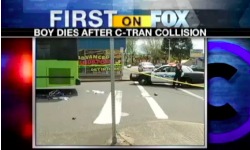
[The story was written by contributor Michael Andersen.]
As Vancouver reels from the death of an 11-year-old boy who was crushed by a C-Tran bus while riding his bike through the intersection of Main and 27th on Saturday, some have noted a common thread it shares with other recent local tragedies:
Buses turning left.
Vancouver’s transit agency, C-Tran, has launched an investigation into Saturday’s collision; and they haven’t yet finished investigating their previous fatality. In December Margaret McCluskey, 88, was killed in a downtown Vancouver crosswalk by a left-turning bus whose driver was preparing for a quick shuffle across three lanes of traffic to reach a stop one block away.
In TriMet’s most recent bus fatality, in 2010, a left-turning TriMet bus killed two young people who were walking in an Old Town crosswalk. A few months later, a man riding a bike up Portland’s transit mall was nearly killed by a left-turning bus on the northeast corner of Pioneer Courthouse Square.
These circumstances vary – for example, investigators haven’t announced whether Saturday’s victim, Benjamin Fulwiler, had been riding his bike on the sidewalk or in the shoulder facing traffic. But all incidents happened in well-trafficked urban areas, three of them in broad daylight.
This isn’t a fluke. Left-turn fatalities are twice as common between buses and pedestrians as right-turn fatalities, a 2008 federal study found.
As The Oregonian reported in 2010, Des Moines’s transit agency removed all left turns from its system after seven consecutive left-turn collisions.
Part of the problem is geometric.
“When buses turn, they pivot on the rear axle, moving forward and then sweeping an arc as the bus follows through the turn,” the federal study wrote, quoted by Oregonian writer Joseph Rose. “At first glance, it may appear to a pedestrian that the bus is moving straight forward through the intersection when in fact the operator is initiating a left turn.”
Inspired by transit agencies elsewhere, TriMet experimented in 2011 with a system that automatically announced “Pedestrians, bus is turning” in English and Spanish. It didn’t work; announcements either triggered too late, or when they weren’t supposed to. TriMet pulled the plug after three months.
Replacing all of TriMet’s 40,000 daily left turns with three right turns would be impossible, TriMet spokeswoman Mary Fetsch said in 2010, in part because of downtown Portland’s grid of one-way streets.
C-Tran spokesman Scott Patterson said Monday that assessing the agency’s policy on left turns is “certainly something we’re already doing as part of our process.”

turning left on 27th as the boy was crossing 27th.
Meanwhile, everyone involved in Saturday’s fatal collision is grappling with the tragedy. KATU reported that it unfolded as Fulwiler’s mother watched.
Eric Giacchino of Vancouver, president of the year-old bicycle education group Bike Clark County, said that whatever the circumstances around Saturday’s crash, the busy corridor has no great north-south bike route.
Vancouver’s bike network directs riders onto Columbia Street, two blocks west. But Giacchino said Columbia lacks either sharrows or a bike lane, in part because residents have resisted removing free auto parking from Columbia to make room.
Vancouver’s 2004 bike plan calls for both Main and Columbia to get bike lanes eventually.
Giacchino said he hopes Bike Clark County’s two-week bicycle education course, now offered in several Vancouver middle schools, will help improve the whole community’s appreciation for bicycling safely.
“We’re going to expand one school a year every year, until we cover the whole county,” Giacchino said. “That’s my dream.”

